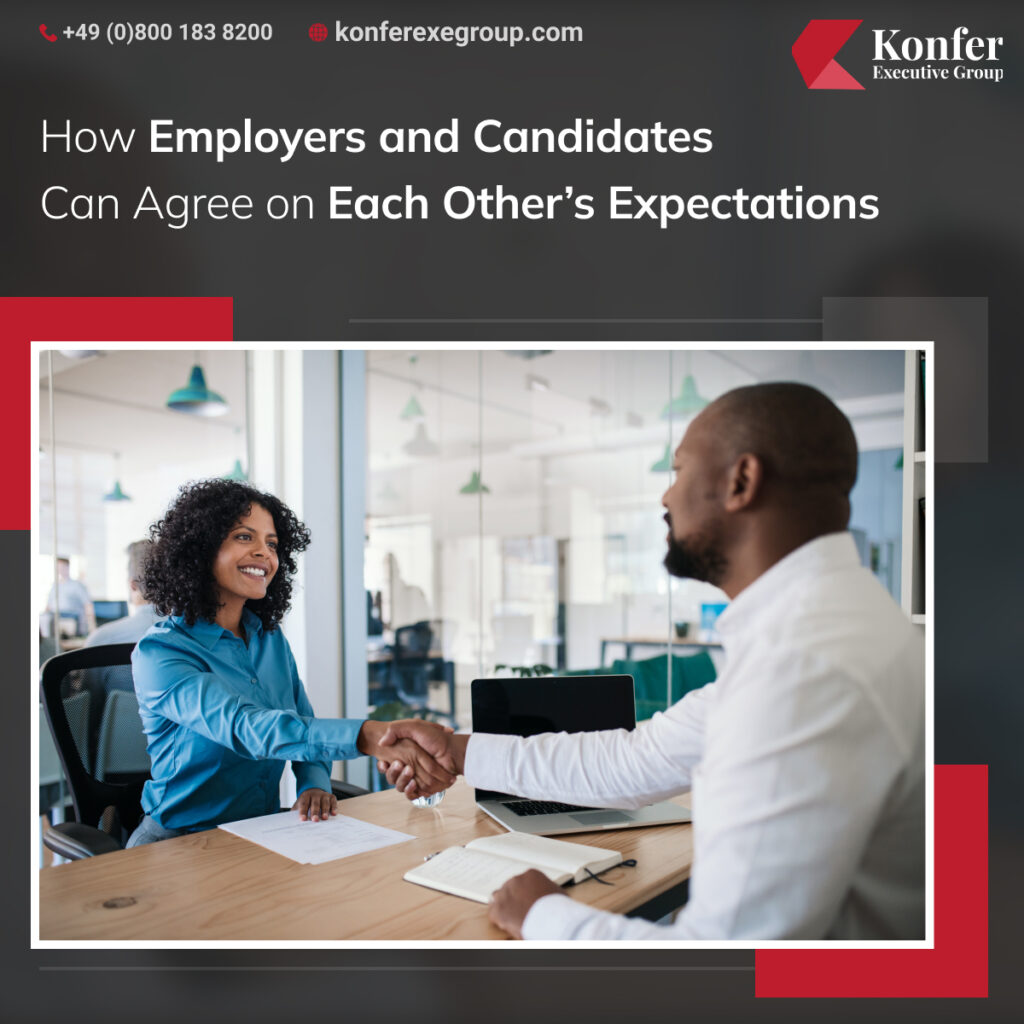When it comes to talent acquisition, employers and candidates have different goals, yet both seek a mutually beneficial, long-term fit. It needs to be understood that hiring and employment have gone through several changes in the last few years, especially after the COVID situation. In other words, it has become hard to get the right candidates for the right jobs. That’s why most organisations these days are knocking on the doors of executive recruiting firms to find the right talent to meet their project goals.
So it begs the question of what the gaps are that are preventing the candidates and the employers from seeing eye to eye regarding their expectations. Well, the most prominent gaps between employers and candidates seem to be the following points:
- On-site vs. work from home
- Compensation
- Vacation & time off
- Hiring timelines
- Onboarding& training

Understanding the Market
Similar to the power shift between buyers and sellers in the market, you will find a shift of power between candidates and employers too in the job market. That’s why it’s essential to have a clear picture of what’s going on in the current market and to set your goals accordingly.
During the time of a labour shortage, employers are required to woo the candidates at the offer stage by selling the company and to give every effort to impress them on their first day.
On the other hand, when the power shifts to the employers or when unemployment is high, it’s now the candidate’s part to sell their skills and experience so that they can get ahead of other candidates in the competition to get the job.
Irrespective of the market conditions, it’s the responsibility of both the employers and the candidates to build a relationship that will thrive for years. The goal is not to win a negotiation but to come to a mutually beneficial job offer or to decide the scope is not right and amicably part ways.
Gap 1: On-site vs. Work from Home
Discuss together
What are the demands of the position? Is being on-site an essential requirement of the position? Can it be done remotely just as successfully? Can a hybrid model be created?
- Discuss together
Why is the applicant seeking remote work? What level of flexibility do they require, and are there any alternative methods to provide it? (For example: flexible hours.)
- Candidates can ask employers
If remote work or hybrid work are initially not feasible, is there a prospect for remote work in the future after the applicant has completed training and is performing well in the position?
Gap 2: Compensation
One must understand that there are several differences between what employers want to pay and what candidates are expecting as compensation.
- Discuss together
It’s not just about salary. A total compensation may comprise of a signing bonus, performance bonus, holiday bonus, commission, longevity bonus, health and wellness benefits, time off, child care, equity or profit sharing, vehicle allowance, retirement and savings plans, etc.
Also, one should discuss together what influences the organisation’s compensation strategy. Is it dependent on seniority? An agreement for collective bargaining? Is internal justice or equity a criterion for what can be offered?
- Employers ask yourself
What’s the condition of the market? What offers are being made by the competitors?
- Tip for both employers and candidates
Be wary of internet salary recommendations since they rapidly become out-of-date and sometimes ignore the specifics of a job’s scope or location. Consult an experienced recruiter who specialises in that position, sector, and area if you need help.
Gap 3: Vacation and Time Off
Several employers are offering 2-3 weeks of vacation, but candidates are often looking for 3 weeks or more.
- Discuss together
What does the whole package entail? What other leave options (personal days, sick days, etc.) are available, and when may they be used? Does the number of vacation days grow with time, and is the timing negotiable?
One must also discuss what factors are driving the company’s vacation policy. Is it dependent on seniority? An agreement for collective bargaining? Does it take internal equity and fairness into account in what may be provided to new recruits?
- Work hours
It is also important to discuss if there’s any flexibility in work hours and if the employees can take personal appointments during the workday.
- Employers should find out
Why is the candidate requesting a longer vacation? What did they do at their prior employment? Are they switching industries, and if so, how well do their expectations match up with this new sector? What vacation policies do the competitors have?
- Both consider
How far are you willing to compromise? Is this issue of utmost importance?
Gap 4: Hiring Timelines
At the time of hiring, employers either move slowly or lose candidates, or start rushing, which scares them off.
- Discuss together
What does the timeline look like for each party? What kind of urgency does the company have in filling the position, and why? When and why can the candidate start? Are both sides willing to compromise?
- Employers
Share hiring timelines and communicate clear expectations for the following steps. Keep a balance between rushing and moving too slowly. It should be noted that headhunted candidates can often react differently compared to others who voluntarily applied for the position. Headhunted candidates usually take more time to consider a job offer, and they are more likely to get a counteroffer from their last employer.
Gap 5: Onboarding and Training
Candidates look for strong onboarding, mentorship, training, and coaching. Employers like to hire people who have good insight into the job and can ramp up quickly.
- Employers
It is wise to effectively conduct screening and interviewing for the required skills. In case the required skills are in short supply in the market, consider hiring coaches with the ability and aptitude to create a correspondingly strong training programme.
- Candidates
Candidates can ask employers whether any onboarding and training are provided to the employees.
- Tip for employers
Create a robust onboarding programme. This will guarantee that new employees are effectively integrated into the company, help them achieve success quickly, increase retention, and lower turnover.
- Tip for candidates
When you are recruited, you may make your onboarding process better by telling your supervisor if there are any training gaps.
Final Thoughts
Lack of communication between the employer and candidates regarding their goals and expectations often results in the employer losing a skilled employee and the employee losing a good job opportunity. Make sure to understand the person across the negotiation table with regard to their goals, motivations, and values.
Don’t presume that a candidate is simply interested in pay. Work-life balance, job security, flexibility, paid time off, opportunity for professional advancement, inclusion, and equality policies, and a sense of purpose in their work are just a few of the factors that influence how individuals choose their professions. Every company also has unique business goals, difficulties, financial constraints, and hiring priorities. Negotiations should be approached with curiosity and an eye towards original ideas. Strive for a fair trade that benefits both sides equally and leaves them feeling valued.

